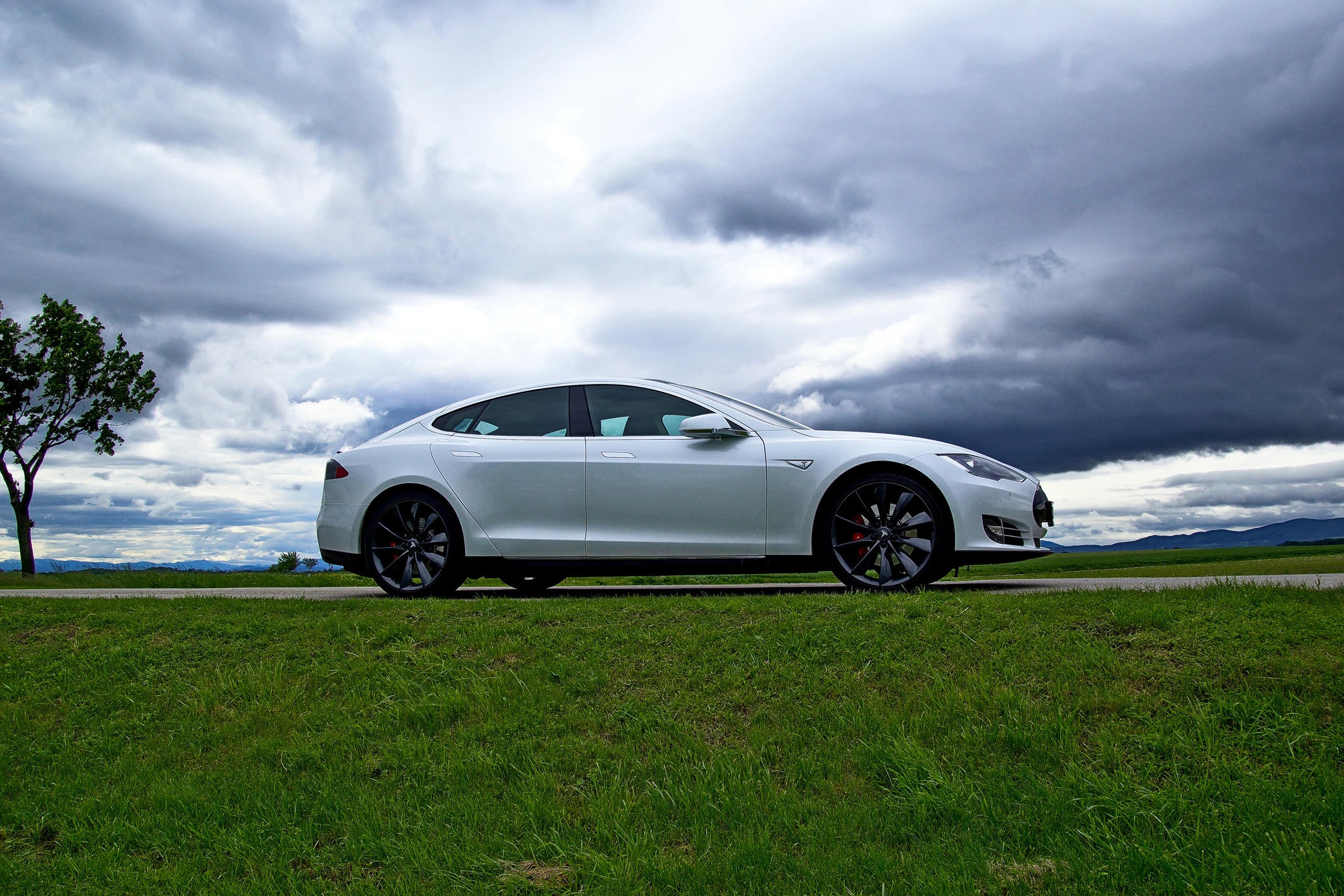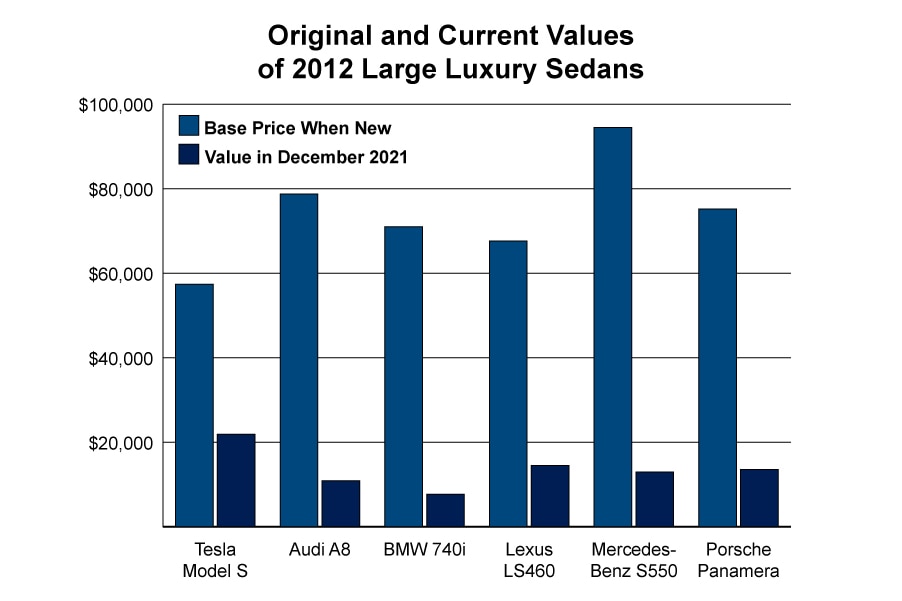The Original Tesla Model S is now 10 Years Old: Here's What We've Learned About Its Resale Value
Tesla's flagship electric car revolutionized the auto industry and people still respond to its novelty by paying relatively high prices for used examples.
 Getty Images
Getty Images
Article QuickTakes
What a difference a decade makes. Ten years ago, Tesla was known only for a niche sports car that cost more than $100,000 and sold in tiny volumes, with about 2,450 examples finding homes over the Roadster's five-year run. Now, the automaker sells some 500,000 vehicles a year, and its value as a company has surpassed the trillion-dollar mark—nearly exceeding that of all other automakers combined.
Much of that success is due to its flagship sedan, the Tesla Model S, which helped inspire the current industry-wide push for EVs and minted Tesla's reputation for going against the status quo. For instance, Tesla spends no money on advertising. It creates its own publicity, mainly through livestreamed vehicle debuts, provocative tweets by CEO Elon Musk, and big stunts like launching a car into space. It also has its own way of serving customers, employing a direct-sales model that eliminates the need for traditional dealerships.
Now that the original 2012 Tesla Model S is 10 years old, we're learning that it also bucks another trend: resale value. While most large luxury sedans depreciate rapidly, the Model S holds its value surprisingly well. Used Model S buyers are paying well above what they would pay for a similar gas-powered luxury sedan such as an Audi A8, BMW 7 Series, Lexus LS, Mercedes-Benz S-Class, or Porsche Panamera.

Base pricing from manufacturer data and current value from Manheim Market Reports, December 2021. Eric Tingwall/Telemetry Agency.
Tesla Model S Depreciation
We analyzed the current values for 2012 models of those luxury competitors and the Model S with nearly 140,000 miles on the odometer, then compared them against the original purchase prices for base models. Today, a Model S that was originally $57,400 is still worth 38 percent of that price, or $21,900. The competitor that comes closest to matching that, the 2012 Lexus LS, holds just 21 percent of its value with similar mileage. A BMW 740iL that was originally priced at $71,000 is now worth $7,725—just 11 percent of the MSRP.
There are still gas cars that retain value better than Teslas—a 2012 Toyota Camry with about 140,000 miles is worth 47 percent of its original price—but it's clear that Tesla cars are not your typical luxury vehicles, particularly when it comes to Model S depreciation. The data suggest that used Tesla buyers aren't afraid of expensive batteries going bad or Tesla's stock price crashing down on the company. On the contrary, they are paying a premium to drive a vehicle that was an unproven curiosity a decade ago. Why? We have theories.
The Model S Is a Status Symbol
What car you drive says a lot about you. Buying a Tesla signifies you're open to innovation, electric power, and ground-breaking technology that pushes the limits of the law and inspires other companies to think differently. That's true whether you drive a new Tesla or a 10-year-old model, but the same can't be said of driving a gas-powered luxury sedan. In the eyes of many car buyers, driving a prior-generation BMW or Mercedes-Benz only says that you can't afford the newest version.
Rather than releasing major generational redesigns like every other automaker, Tesla has steadily evolved the Model S year after year. Today's Model S delivers significantly more driving range and more advanced driver assistance systems than 2012 cars, but it still has the same basic shape and style as the original. That helps the used Model S ride on the prestige of the newest versions. Your neighbor will probably never know that your
Owning a Model S—used or new—says to the world that you have money, and you're investing it (ostensibly wisely) in a vehicle that can gain new capabilities via over-the-air updates—a feature spearheaded by Tesla. And while the 2012 Model S couldn't retroactively support Autopilot when the tech launched in 2015, it did gain software and firmware updates that adjusted the car's range rating and throttle response as well as enabled fast charging at Tesla's proprietary Superchargers. This makes even early versions of the Model S different from traditional luxury sedans of 2012, which lack the ability to change over time and thus grow only more obsolete with each passing day.
The Model S Is the Future but Not Unrecognizable
Luxury-car buyers used to want a vehicle with a robust powertrain, an interior swathed in supple leather, and an arsenal of the latest technology that made life on the road easy. They still want that, only now some of them want that powertrain to run on electricity instead of fossil fuel and that arsenal of tech to include driver-assistance features that make life on the road so easy the driver can let the car do most of the work. The Model S exists to please those people. It comes in a shape people recognize—albeit sleeker and less adorned than the typical luxury four-door—with powerful motors providing rapid acceleration, a minimalist yet posh interior that feels airy and modern, and a highly advanced tech suite that gives you a glimpse of the (distant) fully automated future. Now that Tesla has built up its Supercharger network and improved the capacity of its batteries to support longer ranges, the future has never looked brighter for EVs like the Model S.
Plus, the Model S, by and large, remains ahead of its time and the competition, which keeps demand high even on the used-car market. Many people want to know what all the fuss is about but can't afford to buy one new, so they bide their time and compete for limited preowned examples.
The Model S Has Fans for Life
Why are they limited? Because Tesla has an ardent and loyal fan base, full of owners who take loving care of their vehicles. Many owners see little reason to buy new ones. Early adopters of the Model S, in particular, tend to hang on to their cars longer than other luxury-car buyers, according to an analysis by iSeeCars. Perhaps that's due to over-the-air updates keeping their cars current or because owners take pride in having an early example, as it shows they took a chance on an unknown entity that paid off. But whatever the reason, their resistance to sell helps elevate the car's residual value. And with so many people content with decade-old cars, it makes sense that those without one would want to see what all the hype is about.



